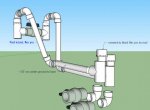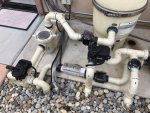Hi everyone! Couple of questions around plumping a solar heat kit we got with our new pool kit.
The kit came with this diverter:
https://www.amazon.com/Smartpool-SK35-Replacement-SunHeater-Aboveground/dp/B00C4063TQ/
The instructions call for the two tee's to be connected with the valve in the middle. So the pipes running to the solar collectors would always be open, just a the bypass would be open to closed.

I will be mounting the panels on the roof, I'm guessing there shouldn't be much issue, but this seems different than what i see others doing on here. Any concerns here?
Assuming that's an ok way to control it, I'd like to think towards the future when I might want to automate this and add an actuator. I worried this valve won't be able to be automated (but I have no idea).
Should I switch it out for something now (if so, what?) or would this work with some type of actuator/automation?
Since all my other plumping is 1-1/2" I plan to just run the same size sch40 PVC from my pump area under ground to a barn about 35-40 feet away. the barn is a few feet down hill where I can add a drain to each side. I plan to just put two ball valves on a 90. Will that cause any issues pumping up to the roof?
I assumed I should pump the water in from the bottom of the bypass, something like this:

Or could I simplify this by pumping in from the top plump the panels to the bottom of the bypass?
I'm considering using flexible PVC tubing from the ground up to the panels on the roof (and connections to/from pool).
Would this work? Or so should I stick with rigid PVC? Is there other flex PVC I should consider?
https://www.amazon.com/gp/product/B01CB65924/
Look forward to hearing your feedback! and thanks for any advice you can share!!
The kit came with this diverter:
https://www.amazon.com/Smartpool-SK35-Replacement-SunHeater-Aboveground/dp/B00C4063TQ/
The instructions call for the two tee's to be connected with the valve in the middle. So the pipes running to the solar collectors would always be open, just a the bypass would be open to closed.

I will be mounting the panels on the roof, I'm guessing there shouldn't be much issue, but this seems different than what i see others doing on here. Any concerns here?
Assuming that's an ok way to control it, I'd like to think towards the future when I might want to automate this and add an actuator. I worried this valve won't be able to be automated (but I have no idea).
Should I switch it out for something now (if so, what?) or would this work with some type of actuator/automation?
Since all my other plumping is 1-1/2" I plan to just run the same size sch40 PVC from my pump area under ground to a barn about 35-40 feet away. the barn is a few feet down hill where I can add a drain to each side. I plan to just put two ball valves on a 90. Will that cause any issues pumping up to the roof?
I assumed I should pump the water in from the bottom of the bypass, something like this:

Or could I simplify this by pumping in from the top plump the panels to the bottom of the bypass?
I'm considering using flexible PVC tubing from the ground up to the panels on the roof (and connections to/from pool).
Would this work? Or so should I stick with rigid PVC? Is there other flex PVC I should consider?
https://www.amazon.com/gp/product/B01CB65924/
Look forward to hearing your feedback! and thanks for any advice you can share!!




